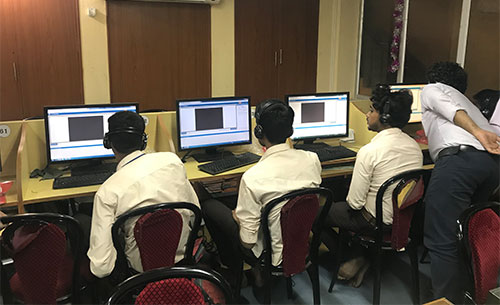- LAN – The language lab system works on local area networking. The systems are connected through local area networks or audio cabling for the smooth running of the software. LAN connection allows the teacher to see the computer screen of all the students and access them.
- Microphones – Microphones are used with headsets by teachers and students to communicate the English learning exercises and other activities for effective learning.
- Intercom switches – It is used for two way communication process. The teacher pronounces a word and asks students to pronounce in the same accent.
- Headphones – Headphones are used to listen to interactive video lectures for learning English skills content covered in digital language lab software.
- The media player / recorder – A recorder is used to record voice, audio recorder facility is provided in language lab software to record the voice and improve their accent. A teacher can assign them the lessons of reading a passage and ask them to record it.
- Monitoring switches – It enables the teacher to listen to the voice of the students whether they are pronouncing the word or sentence incorrect accent so that she can advise them and correct them.
Four Important Core skills of English language
The above components are important for efficient learning of English skills. They help you quickly understand the concepts of English through interactive and multimedia-based content.
The four important core skills of English language are listening, speaking, reading and writing i.e. LSRW technique.
Listening Skills
To acquire any knowledge we first begin with listening to that language until we listen to something, how we will grab it. In a class, the objective of a teacher is to inform the students about a particular topic and make them earn and understand readily.
Speaking Skills
Speaking is the second language skill. Speaking skills give us the ability to communicate effectively. When we listen to something repeatedly then we can learn, understand and also mimic the style of speaking that language. In the digital language lab, students are asked to listen to the topic and then try to speak.
Reading Skills
School Management software facilitates reading exercises with dictionaries and phonetics that help the students in a better understanding of exercises. This is very useful for the students to improve their reading vocabulary, a grammar section, fluency and comprehension skills.
Writing Skills
Writing is an important part of communication. Good communication skills help you to communicate your message with clarity. Communication skills lab help in improving writing skills which will automatically enhance the communication skills among students and bring confidence.



